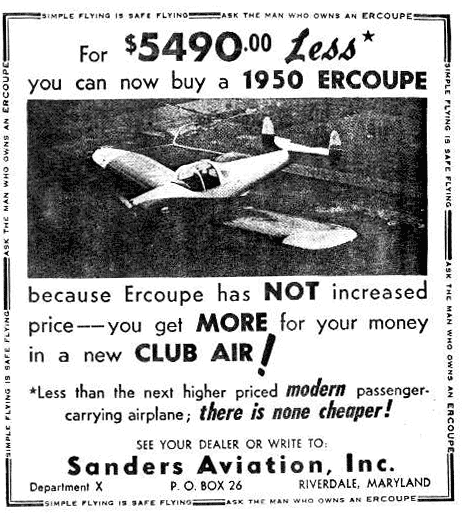Pilot's Report - NEW ERCOUPE part Three
The Ercoupe for 1950 is available in two versions: regular two-control model or the standard three-control
By A.H. Hasbrook
The following day we went back to the field to fly the three-control Ercoupe with Chief Test Pilot Thommy Thompson who, incidentally, has been wanting a three control Ercoupe for a long time. Although he'd completed almost all the paper work necessary for final certification of the three-control model, we had to wear chutes for the flight check.
Once in the ship and with the engine warming up (the day was colder and much more gusty that the previous one), Thompson went over a few of the details involved in the changeover to three control. First of all, although both the two- and three-control Ercoupes have the same respective aileron, rudder and elevator displacements, the rudder and ailerons are completely disconnected from each other in the three-control design.
Also the brake pedal is eliminated to make room for installation of the welded steel tube rudder pedals. Brake application is accomplished by means of the parking brake. This we didn't particularly like because of the heavy pull required.
When mentioned this to Thompson, he reported they were working on a lever-action handle which would probably be put into production if sales warranted such re-design. He also mentioned that anyone who wanted to change older model Ercoupes over to three-control could do so with the $150 kits soon to be made available.

From the moment we started taxiing out for take-off, we were impressed with the ship. Steering is accomplished either in the conventional Ercoupe way by using the wheel; by rudder alone at moderate speeds , or by a combination of both. The take-off in a strong 30 mph crosswind was executed easily by keeping the wheel rolled slightly to the wind ward side and use of downwind rudder. To keep the nose wheel from skidding, we applied just enough back pressure to take the load off the tire. The ship came off nicely and responded quickly when we ruddered against the gusty air. Duplicating the two-control check procedure of the previous day, we found no differences in climb and cruise performance. Straight and level flight in the prevailing rough air, however, was where the three-control job really pleased us. Yaw, due to gusts, was decreased by rudder use to a point comparable to any other stable conventional airplane, so much so that we found it possible to fly 'hands off' for long periods of time.
In the stall tests the airplane responded just as well as the two-control model. Thompson then took over and showed us the 'clincher'. At 2.000 feet he applied full throttle, pulled the Ercoupe into a power stall and then proceeded to keep the wheel all the way back. As the nose oscillated up and down, he kept the wings level with rudder and called our attention to the altimeter. Instead of gradually losing altitude from each 'dip', the ship lost only as much as it had gained during the previous swing up and we continued to remain at or above the 2000 foot level.
On the way back to ERCO Field, Thompson suggested we drop into a deserted Navy strip that was right on our course. Coming around the field, we noticed the sock was standing almost straight out, indicating a good 45° to 50° crosswind. Thompson made the first approach, crabbing to stay aligned with the runway. Just before touching down, he ruddered the ship straight and we landed perfectly. During the landing roll, he demonstrated how easily either the wheel or the rudder could keep the Ercoupe rolling straight down the runway. Then Thompson suggested we try a take-off downwind, crosswind!
Except for a longer ground run, the ship got off just as easily and nicely as it had in the previous head crosswind take-offs, and the stability was excellent throughout!
Our reason for preferring the three-control Ercoupe rather than the two control design are these: improved crosswind take-off and landing characteristics; elimination of almost all yaw effects in rough air; improved stall characteristics and control and low speeds and, lastly an intangible sense of a more solid 'feel' to the airplane. But regardless of which control type is desired, the Ercoupe is a darn nice airplane!
The price?... The Club-Air lists at$3995, plus another $150 for three-control and it's worth it.
SKYWAYS